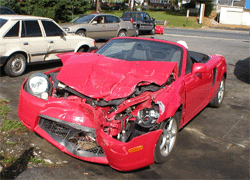The start of summer signals vacation travel for millions and millions of Americans. And, the travel choice for most of them is still the road trip. A great deal of planning and preparation generally goes into making vacation travel as enjoyable as possible. Everything from the most interesting and fun filled attractions to the perfect hotel are taken into account. “But have you thought about driver fatigue in your travel plans? It’s probably one of the most unsettling experiences for drivers and poses a very real danger, too,” says Sheriff Mike Tregre.
Imagine this scenario. You’ve been driving for what seems like endless hours. The highway is long, too long and monotonous. You’re tired. The music on the radio has now become boring and isn’t holding your attention, and neither is driving. Staring straight ahead at the miles and miles of road left to drive, your head bobs and your eyes slowly close. You are asleep.
I n a flash, you open your eyes and realize that your car has drifted out of your lane, maybe even off the road. You quickly steer your car back into the lane, take a few deep breaths and realize that you were actually asleep at the wheel!
n a flash, you open your eyes and realize that your car has drifted out of your lane, maybe even off the road. You quickly steer your car back into the lane, take a few deep breaths and realize that you were actually asleep at the wheel!
According to the National Highway Traffic Safety Administration, falling asleep while driving is responsible for at least 100,000 automobile crashes, 40,000 injuries and 1550 fatalities every year. These crashes happen between the hours of midnight and 6:00 a.m., involve a single vehicle and a sober driver traveling alone. But, these figures underestimate the true level of involvement of drowsiness because they do not include crashes involving daytime hours, multiple vehicles, alcohol, passengers or evasive maneuvers.
What causes driver fatigue?
Sheriff Tregre stated, “There are several culprits which can cause driver fatigue, including alcohol consumption. Just one drink can make a difference. Another culprit is the very nature of highway driving. Vehicles designed for comfort and easy maneuvering, combined with roads and highways engineered to eliminate sharp curves, contribute to falling asleep at the wheel.
“Add to this mix what is known as ‘highway hypnosis,’ which includes dull landscapes, the droning of the tires and engines, and the repetitious sight of trees, utility poles, headlights and the highway center, and you’ve got all the makings for driver fatigue.”
How to prevent driver fatigue?
Sheriff Tregre suggests the following tips developed by the National Safety Council for staying awake while you’re driving:
An obvious cause of fatigue is lack of sleep. If you haven’t received seven or eight hours of sleep the night before a trip, you’re courting fatigue. Get enough rest. And don’t start a trip late in the day. Long distance is hard work, and you need to be fresh and alert.
- If possible, don’t drive alone. Passengers can take turns driving and also
serve as conversation partners to keep you awake. - Avoid long drives at night. The glare of lights, both on your dashboard and
outside your car, increases the danger of highway hypnosis. - Adjust your car’s environment so that it helps keep you awake and
alert. Keep the temperature cool, with open windows or air conditioning in
the summer and frugal amounts of heat in the winter. Turn the radio volume
up, and switch stations frequently, but avoid soft, sleep inducing music. Do
not use cruise control; keep your body involved with driving. - Watch your posture. Drive with your head up and your shoulders back. Tuck
your buttocks against the seat back. Legs should not be fully extended but
flexed at about a 45 degree angle. - Take frequent breaks. At least every two hours, stop at a gas station,
restaurant or rest stop. Get out of the car, walk around, even jog or do
calisthenics. Exercise fights fatigue. - In addition to exercise breaks, stop for light meals and snacks. Avoid alcohol
entirely. - Don’t allow your eyes to become fatigued or hypnotized. Wear sunglasses to
fight glare (but never wear sunglasses at night). - Break the monotony. Turn the radio on far a while, then off. Vary speed
levels. Chew gum. Stretch your legs, slap your thighs. Talk to yourself.
Sing. Keep your eyes moving. - If anti fatigue measures fail, and you start noticing the danger signs of
fatigue, then there is only one solution. Sleep. If no motels or rest areas are
in sight, pull off the road in a safe area which is well-lit and take a nap.
Even 20 minutes of sleep might refresh you enough to keep going until you
reach a safe area.
Sheriff Tregre concluded, “More vehicle injuries and fatalities occur during the summer than any other season. Don’t let driver fatigue ruin your travel plans. ‘Buckle-up,’ drive safely and have a great vacation.
